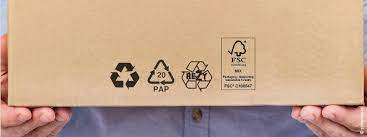Environmental labelling of packaging is information provided to consumers about the environmental impact of packaging during its life cycle. From January 1, 2023, environmental labelling of packaging will be mandatory for all packaging on sale in the European Union.

The aim of environmental labelling of packaging is to provide consumers with transparent and easily understandable information on the environmental impact of packaging, enabling them to make more conscious and sustainable choices. Environmental labelling of packaging is based on a system for assessing the environmental impact of packaging, which takes into account various factors such as the use of renewable raw materials, energy consumption during production, the volume of waste generated and the recycling of packaging.
Environmental labelling of packaging will be mandatory for all packaging on sale in the European Union, regardless of the country of origin. Packaging must be labelled with an icon indicating its environmental impact, based on a scale of assessment ranging from A (the most sustainable) to E (the least sustainable). Companies will be responsible for the environmental labelling of packaging and will have to provide evidence of their accuracy.
Environmental labelling of packaging is an important step towards greater sustainability and transparency in the packaging sector. It will help promote the use of more sustainable packaging and reduce the environmental impact of the packaging industry. It will also provide consumers with valuable information to make more sustainable choices when purchasing packaged products.
Can a QR code be used to provide information on environmental labeling of packaging?
Yes, it is possible to use a QR code (Quick Response Code) to provide information on environmental labeling of packaging. A QR code is a matrix of small square dots that can be scanned with a smartphone or QR code reader to access online information.
In this case, the QR code could be used to provide detailed information on the environmental impact of packaging, such as the use of renewable raw materials, energy consumption during production, the volume of waste generated and the recycling of packaging. The QR code could be printed on the packaging or product packaging and could be used by consumers to access this information easily and conveniently.
However, it is important to note that the use of a QR code to provide information on environmental labeling of packaging is only an option and is not mandatory. Companies may choose to provide information on environmental labeling of packaging in other ways, such as through the company's website or by using labels or visual signals on the packaging.
More information about the eLeaflet solution from myHealthbox and how we can help you comply with these new regulations is available on the eLeaflet website